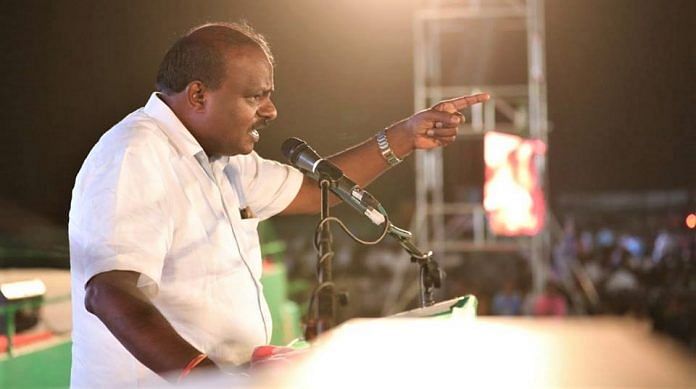Supreme Court judgments are clear: The governor must invite whoever appears to have a majority.
Supreme Court judgments and precedents are very clear about what the Karnataka governor should do. His job is to evaluate who is more likely to have a majority: H.D. Kumaraswamy or B.S. Yeddyurappa? The governor doesn’t have to invite the single largest party to form the government. He has to invite whoever seems more likely to have a majority.
The Congress and the JD(S) have unambiguously and publicly formed a post-poll coalition. Their numbers, added together, are past the majority mark. The governor should invite this coalition to form the government and prove on the floor of the house that they have a majority.
The hypocrisy of the Congress and the BJP is a non-issue. Last year, when the governor of Goa ignored the fact that the Congress was the single largest party and instead invited the BJP to form the government, she did so because she felt the BJP had already cobbled up a majority.
The Supreme Court had upheld her decision, observing “When no political party is in majority, then it is the bounden duty of the Governor to see who can form the government. If nothing happens, then the Governor is duty-bound to call the leader of the single largest party but if someone goes to the Governor with a list of supporters, then it is a different issue altogether.”
Something similar had happened in Manipur. Basically, the governor is not bound to invite anybody in a hung assembly. She or he has the discretion to decide who appears to have the majority. The Supreme Court has repeatedly asserted that the majority has to be proved on the floor of the house as soon as possible.
The history of this convention also has to do with Karnataka. In April 1989, S.R. Bommai, the 11th chief minister of Karnataka, was dismissed by the President of India on the recommendation of the governor. The governor made this recommendation because there were MLAs from the treasury benches running to Raj Bhavan making contentious claims about many legislators withdrawing support to the government.
The deposed chief minister went to the Supreme Court that set up a Constitutional bench of 9 judges. This bench ruled, amongst other things, that majorities are to be established only on the floor of the house. In other words, the then Karnataka governor should have asked Chief Minister Bommai to prove his majority on the floor of the house before recommending President’s rule.
The Bommai judgment ended the casual dismissal of state governments under Article 356. But it also affected what the President or Governor is to do in the case of a hung assembly. In such an event, the governor has to invite whoever seems most likely to have a majority and then prove the majority on the floor of the house.
The idea was further refined in Rameshwar Prasad v. Union of India in 2006, where the Supreme Court said what the governor should do if he is not sure who has a majority. However, in the case of the Karnataka results there is no such uncertainty. It is very clear that a post-poll coalition, that of the Congress and the JD(S), has a majority.
It would have been a case of uncertainty if the JD(S) was not revealing its cards and both the Congress and the BJP had staked claim to form the government. In such a case, the Rameshwar Prasad judgment says the governor must invite the single largest party, having made sure there is no pre-poll alliance with a majority.
The trouble with blindly inviting the single largest party to form the government is that it may not have a majority and fall. The governor’s job is to make sure there’s a stable and viable government in place as soon as possible.
In 1989, Rajiv Gandhi chose to not form the government despite leading the single largest party, the Congress, in a hung Lok Sabha. He wasn’t sure he’d be able to put together a coalition majority.
In 1996, President Shankar Dayal Sharma had invited Atal Bihari Vajpayee to form the government as his party, the BJP, had the single largest number of MPs. The government lasted 13 days.
When Vajpayee was again invited to be PM in 1998, it was only after President K.R. Narayanan took letters of support from the coalition. Narayanan wanted to be sure that Vajpayee had a majority that he would be able to prove on the floor of the house. He wanted to avoid the 13-day government fiasco of 1996.
In other words, the deciding principle is ‘who has the majority?’ Since the Congress has already declared support to the JD(S) in writing, it is clear that H.D. Kumaraswamy has the support of a majority of the MLAs, which B.S. Yeddyurappa does not. This is why the Karnataka Governor must invite Kumaraswamy to form the government.



